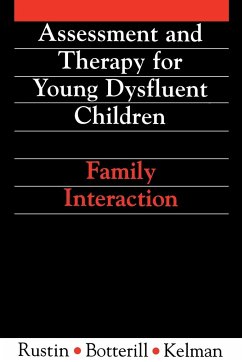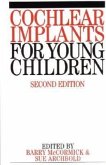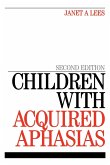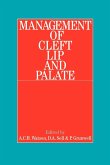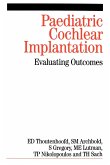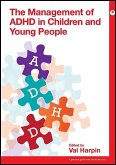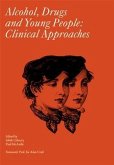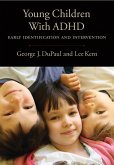- Broschiertes Buch
- Merkliste
- Auf die Merkliste
- Bewerten Bewerten
- Teilen
- Produkt teilen
- Produkterinnerung
- Produkterinnerung
Clinicians continue to be anxious about the assessment and treatment of dysfluency, but all the evidence suggests that early intervention is of primary importance in preventing long-term chronic stuttering. This practical programme aims to provide the means to assess the child's speech and language and the family life-style, to identify the children at risk and to plan appropriate treatment for the child concerned.
Andere Kunden interessierten sich auch für
![Cochlear Implants for Young Children Cochlear Implants for Young Children]() Barry MccormickCochlear Implants for Young Children140,99 €
Barry MccormickCochlear Implants for Young Children140,99 €![Children with Acquired Aphasias Children with Acquired Aphasias]() Janet LeesChildren with Acquired Aphasias80,99 €
Janet LeesChildren with Acquired Aphasias80,99 €![Management of Cleft Lip and Palate Management of Cleft Lip and Palate]() A. WatsonManagement of Cleft Lip and Palate154,99 €
A. WatsonManagement of Cleft Lip and Palate154,99 €![Paediatric Cochlear Implantation Paediatric Cochlear Implantation]() Ernst ThoutenhoofdPaediatric Cochlear Implantation104,99 €
Ernst ThoutenhoofdPaediatric Cochlear Implantation104,99 €![Management of ADHD in Children and Young People Management of ADHD in Children and Young People]() Val HarpinManagement of ADHD in Children and Young People49,99 €
Val HarpinManagement of ADHD in Children and Young People49,99 €![Alcohol, Drugs and Young People Alcohol, Drugs and Young People]() Eilish GilvarryAlcohol, Drugs and Young People77,99 €
Eilish GilvarryAlcohol, Drugs and Young People77,99 €![Young Children with ADHD: Early Identification and Intervention Young Children with ADHD: Early Identification and Intervention]() George DuPaulYoung Children with ADHD: Early Identification and Intervention61,99 €
George DuPaulYoung Children with ADHD: Early Identification and Intervention61,99 €-
-
-
Clinicians continue to be anxious about the assessment and treatment of dysfluency, but all the evidence suggests that early intervention is of primary importance in preventing long-term chronic stuttering. This practical programme aims to provide the means to assess the child's speech and language and the family life-style, to identify the children at risk and to plan appropriate treatment for the child concerned.
Produktdetails
- Produktdetails
- Verlag: Wiley
- Seitenzahl: 192
- Erscheinungstermin: 8. Juni 1995
- Englisch
- Abmessung: 234mm x 156mm x 11mm
- Gewicht: 301g
- ISBN-13: 9781897635551
- ISBN-10: 1897635559
- Artikelnr.: 22056381
- Herstellerkennzeichnung
- Libri GmbH
- Europaallee 1
- 36244 Bad Hersfeld
- gpsr@libri.de
- Verlag: Wiley
- Seitenzahl: 192
- Erscheinungstermin: 8. Juni 1995
- Englisch
- Abmessung: 234mm x 156mm x 11mm
- Gewicht: 301g
- ISBN-13: 9781897635551
- ISBN-10: 1897635559
- Artikelnr.: 22056381
- Herstellerkennzeichnung
- Libri GmbH
- Europaallee 1
- 36244 Bad Hersfeld
- gpsr@libri.de
Lena Rustin is the author of Assessment and Therapy for Young Dysfluent Children: Family Interaction, published by Wiley. Elaine Kelman is the author of Assessment and Therapy for Young Dysfluent Children: Family Interaction, published by Wiley.
Acknowledgements vii
Note to readers vii
Foreword ix
Chapter 1 Introduction 1
Onset and development of stuttering 1
Remission 2
Normal dysfluency or early stuttering? 2
Variability 3
A theoretical framework 4
Physiological factors 5
Linguistic factors 7
Environmental/sociocultural factors 8
Psychological and emotional factors 10
Summary 12
Chapter 2 Child Assessment 13
Introduction 13
Child assessment 14
General behavior 16
Cognitive skills 18
Language 19
Social skills 27
Dysfluency 30
Child interview-attitudes 36
Chapter 3 Assessment of Parent-Child Interaction 42
Introduction 42
Interaction analysis 43
Selection of interaction therapy goals 53
Chapter 4 The Parent Interview 58
Introduction 58
The Interview 59
Setting the scene 61
Introducing the interview 61
Parent interview 62
Summary 78
Chapter 5 The Formulation 79
Physiological factors 81
Linguistic factors 82
Environmental/sociocultural factors 82
Psychological/emotional factors 82
Recommendations for therapy 86
Chapter 6 Interaction Therapy 97
Introduction 97
Structure of therapy 97
First therapy session 98
Session format 100
Consolidation period 106
Review 107
Examples of interaction therapy techniques 107
Summary 113
Chapter 7 Family Issues 114
Introduction 114
Environmental issues 115
Emotional issues 123
Summary 132
Chapter 8 Direct Treatment of the Child 133
Direct fluency therapy 133
Language therapy for the dysfluent child 137
Phonological therapy for the dysfluent child 138
Summary 139
Appendix I Child Assessment 141
Appendix Il Picture Material 149
Appendix III Parent Interview 151
Appendix IV The Summary Chart 163
Appendix V Generally Accepted Facts of Stuttering 164
Appendix VI Special Time - Instruction Sheet 165
Appendix VII Five Minutes Special Time Task Sheet 166
References 168
Index 175
Note to readers vii
Foreword ix
Chapter 1 Introduction 1
Onset and development of stuttering 1
Remission 2
Normal dysfluency or early stuttering? 2
Variability 3
A theoretical framework 4
Physiological factors 5
Linguistic factors 7
Environmental/sociocultural factors 8
Psychological and emotional factors 10
Summary 12
Chapter 2 Child Assessment 13
Introduction 13
Child assessment 14
General behavior 16
Cognitive skills 18
Language 19
Social skills 27
Dysfluency 30
Child interview-attitudes 36
Chapter 3 Assessment of Parent-Child Interaction 42
Introduction 42
Interaction analysis 43
Selection of interaction therapy goals 53
Chapter 4 The Parent Interview 58
Introduction 58
The Interview 59
Setting the scene 61
Introducing the interview 61
Parent interview 62
Summary 78
Chapter 5 The Formulation 79
Physiological factors 81
Linguistic factors 82
Environmental/sociocultural factors 82
Psychological/emotional factors 82
Recommendations for therapy 86
Chapter 6 Interaction Therapy 97
Introduction 97
Structure of therapy 97
First therapy session 98
Session format 100
Consolidation period 106
Review 107
Examples of interaction therapy techniques 107
Summary 113
Chapter 7 Family Issues 114
Introduction 114
Environmental issues 115
Emotional issues 123
Summary 132
Chapter 8 Direct Treatment of the Child 133
Direct fluency therapy 133
Language therapy for the dysfluent child 137
Phonological therapy for the dysfluent child 138
Summary 139
Appendix I Child Assessment 141
Appendix Il Picture Material 149
Appendix III Parent Interview 151
Appendix IV The Summary Chart 163
Appendix V Generally Accepted Facts of Stuttering 164
Appendix VI Special Time - Instruction Sheet 165
Appendix VII Five Minutes Special Time Task Sheet 166
References 168
Index 175
Acknowledgements vii
Note to readers vii
Foreword ix
Chapter 1 Introduction 1
Onset and development of stuttering 1
Remission 2
Normal dysfluency or early stuttering? 2
Variability 3
A theoretical framework 4
Physiological factors 5
Linguistic factors 7
Environmental/sociocultural factors 8
Psychological and emotional factors 10
Summary 12
Chapter 2 Child Assessment 13
Introduction 13
Child assessment 14
General behavior 16
Cognitive skills 18
Language 19
Social skills 27
Dysfluency 30
Child interview-attitudes 36
Chapter 3 Assessment of Parent-Child Interaction 42
Introduction 42
Interaction analysis 43
Selection of interaction therapy goals 53
Chapter 4 The Parent Interview 58
Introduction 58
The Interview 59
Setting the scene 61
Introducing the interview 61
Parent interview 62
Summary 78
Chapter 5 The Formulation 79
Physiological factors 81
Linguistic factors 82
Environmental/sociocultural factors 82
Psychological/emotional factors 82
Recommendations for therapy 86
Chapter 6 Interaction Therapy 97
Introduction 97
Structure of therapy 97
First therapy session 98
Session format 100
Consolidation period 106
Review 107
Examples of interaction therapy techniques 107
Summary 113
Chapter 7 Family Issues 114
Introduction 114
Environmental issues 115
Emotional issues 123
Summary 132
Chapter 8 Direct Treatment of the Child 133
Direct fluency therapy 133
Language therapy for the dysfluent child 137
Phonological therapy for the dysfluent child 138
Summary 139
Appendix I Child Assessment 141
Appendix Il Picture Material 149
Appendix III Parent Interview 151
Appendix IV The Summary Chart 163
Appendix V Generally Accepted Facts of Stuttering 164
Appendix VI Special Time - Instruction Sheet 165
Appendix VII Five Minutes Special Time Task Sheet 166
References 168
Index 175
Note to readers vii
Foreword ix
Chapter 1 Introduction 1
Onset and development of stuttering 1
Remission 2
Normal dysfluency or early stuttering? 2
Variability 3
A theoretical framework 4
Physiological factors 5
Linguistic factors 7
Environmental/sociocultural factors 8
Psychological and emotional factors 10
Summary 12
Chapter 2 Child Assessment 13
Introduction 13
Child assessment 14
General behavior 16
Cognitive skills 18
Language 19
Social skills 27
Dysfluency 30
Child interview-attitudes 36
Chapter 3 Assessment of Parent-Child Interaction 42
Introduction 42
Interaction analysis 43
Selection of interaction therapy goals 53
Chapter 4 The Parent Interview 58
Introduction 58
The Interview 59
Setting the scene 61
Introducing the interview 61
Parent interview 62
Summary 78
Chapter 5 The Formulation 79
Physiological factors 81
Linguistic factors 82
Environmental/sociocultural factors 82
Psychological/emotional factors 82
Recommendations for therapy 86
Chapter 6 Interaction Therapy 97
Introduction 97
Structure of therapy 97
First therapy session 98
Session format 100
Consolidation period 106
Review 107
Examples of interaction therapy techniques 107
Summary 113
Chapter 7 Family Issues 114
Introduction 114
Environmental issues 115
Emotional issues 123
Summary 132
Chapter 8 Direct Treatment of the Child 133
Direct fluency therapy 133
Language therapy for the dysfluent child 137
Phonological therapy for the dysfluent child 138
Summary 139
Appendix I Child Assessment 141
Appendix Il Picture Material 149
Appendix III Parent Interview 151
Appendix IV The Summary Chart 163
Appendix V Generally Accepted Facts of Stuttering 164
Appendix VI Special Time - Instruction Sheet 165
Appendix VII Five Minutes Special Time Task Sheet 166
References 168
Index 175

